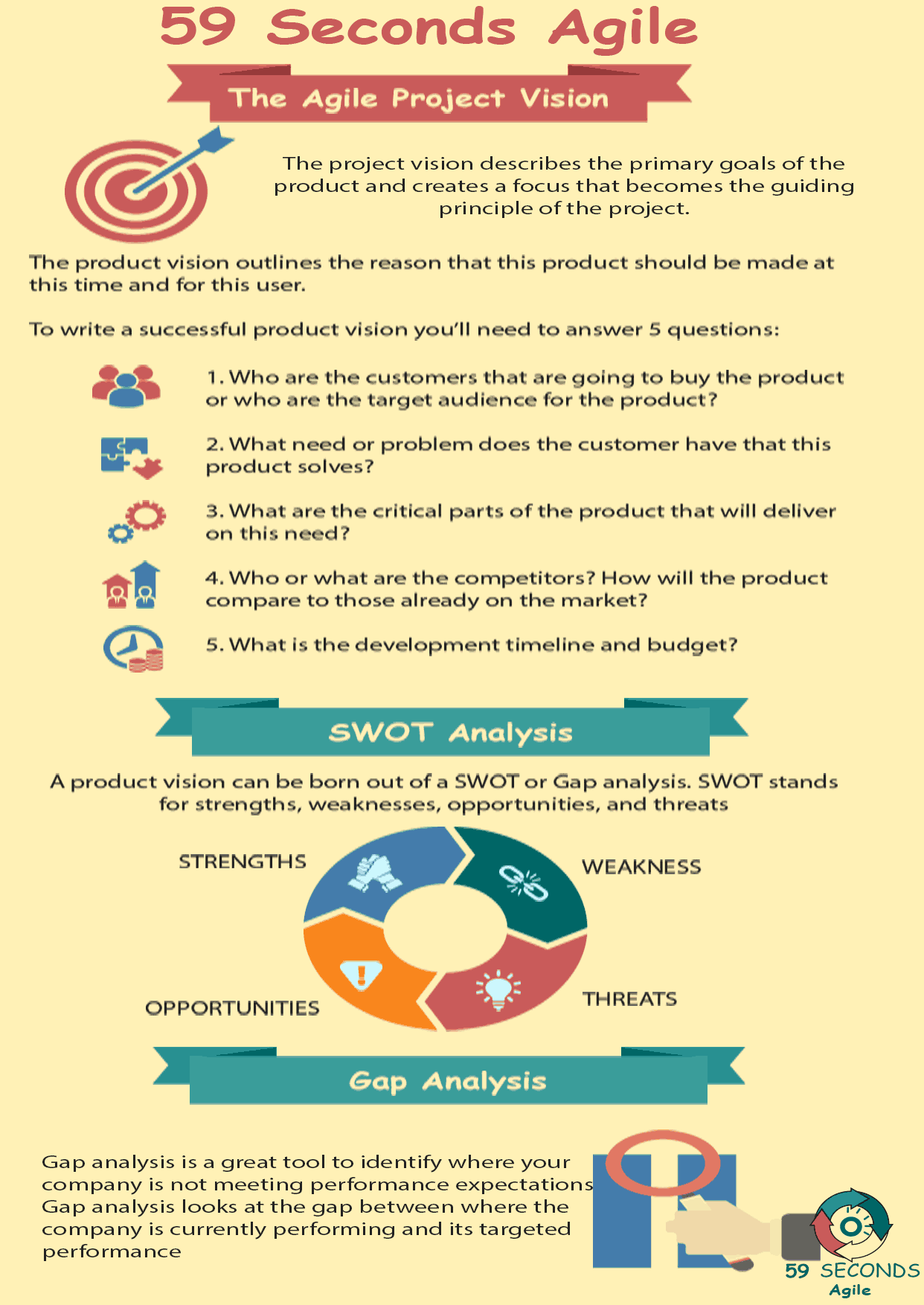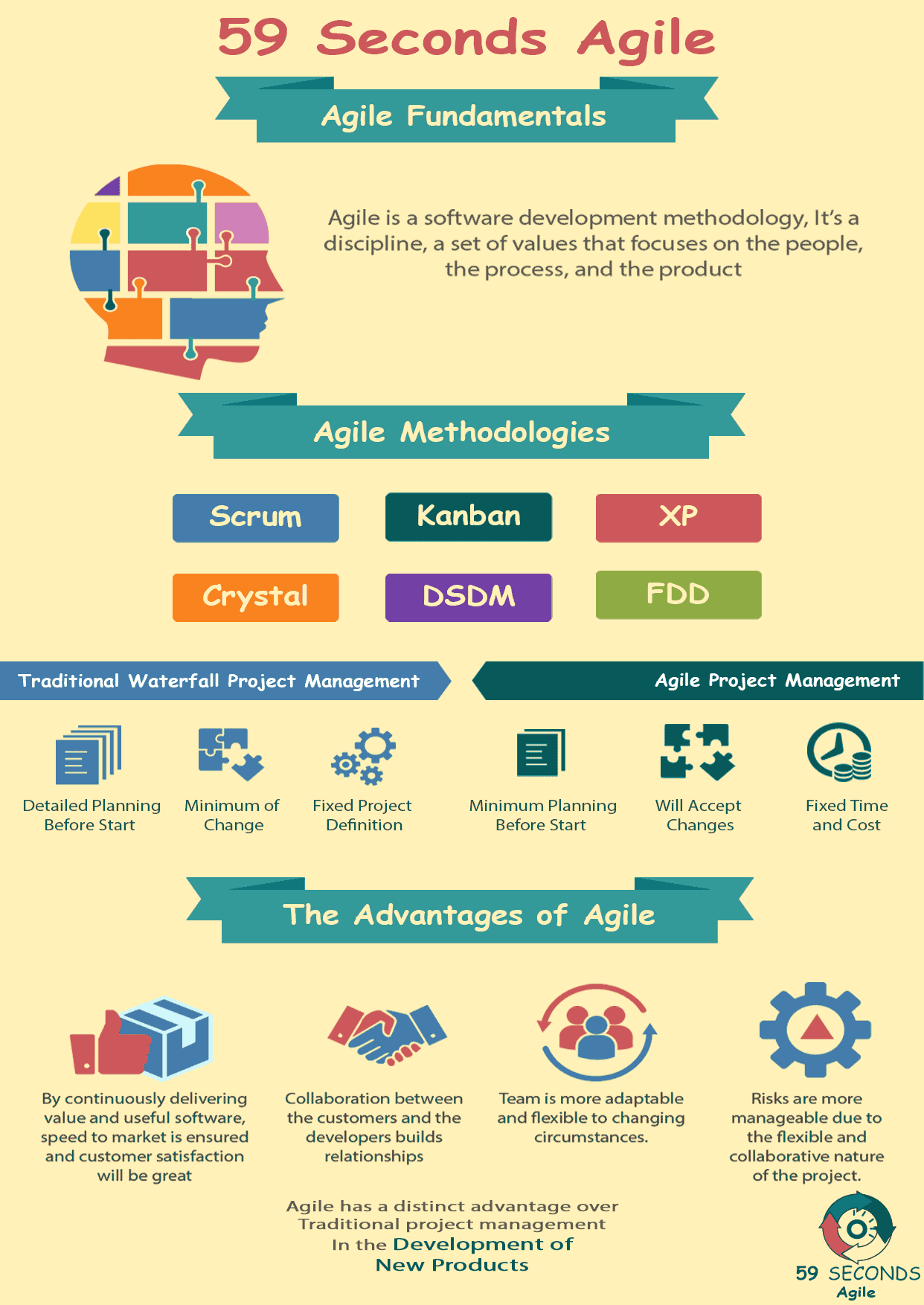This article looks to discuss the Agile Project Vision while focussing on the Scrum Master role. The article starts with how to write an Agile Project Vision.
The Agile Fundamentals
A 59 Seconds Agile Video Animation
Agile Project Vision for Scrum Masters
A 59 Seconds Agile Article
At the heart of any great product is a great vision. It describes the primary goal or goals of a product. It creates a focus that becomes the guiding principle of the project. A good product vision not only becomes a quick elevator pitch to potential investors but also becomes the basis for prioritising and developing the product. The Scrum Master will use this everyday to help the team prioritise their work. This helps to refocus as they discover unforeseen roadblocks or decisions. The product vision outlines the reason that this product should be made at this time and for this user.
Writing a Project Vision
To write a successful product vision you’ll need to answer 5 questions:
1. Who are the customers that are going to buy the product or who are the target audience for the product?
2. What need or problem does the customer have that this product solves?
3. What are the critical parts of the product that will deliver on this need?
4. Who or what are the competitors? How will the product compare to those already on the market?
5. What is the development timeline and budget?

Project Vision: The Questions
If you can answer these questions, then you have a product vision. Anyone who reads the vision statement should also be able to answer the questions above, even if only on a surface level. Sometimes you may have a great idea but you realize while answering these questions that you do not have a full product. Not all great ideas turn into great products if they aren’t solving a need and you cannot develop a full product vision.

Project Vision: SWOT Analysis
A product vision can be born out of a SWOT or Gap analysis. SWOT stands for strengths, weaknesses, opportunities, and threats and by breaking down a company’s current offering into these pieces, it can help identify areas or products worth pursuing. For example, maybe your company specializes in IT support but there is an opportunity for your company to develop a customer support system since one of your strengths is the friendliness of your staff.
Project Vision: Competitor SWOT Analysis
There may also be a threat your company is facing since another competitor began to offer a more robust suite of full IT support. By performing a SWOT analysis it can keep you one step ahead in coming up with new product ideas.
Our Favourite Agile Books
We found these books great for finding out more information on Agile Scrum:
Project Vision: Gap Analysis
Additionally, Gap analysis is a great tool to identify where your company is not meeting performance expectations. Gap analysis looks at the gap between where the company is currently performing and its targeted performance. Maybe the goal was a certain number of users in your app, by looking at this gap you can then develop ideas and product visions on how to solve that problem. In this case, you may look at the Gap and determine you need to put more spending into ads to drive more people to the app or you may determine that you need to develop a new feature within the app that will ensure it is fully differentiated and marketable.
Product Visions for All Products
Product visions are not just great for new products, “business as usual” products can also greatly benefit from this type of visioning. By focusing on the vision, it can help any product stay focused and be developed in tighter iterations. Creating a product vision for things like security or systems upgrades can help turn out the update faster and with a greater focus on solving the problem. A good product or feature enhancement is always solving a problem and by defining the product vision, it helps hone in on that very specific problem and why it’s worth solving. It also helps make an internal business case for why a company needs to put resources against this update at this time.
Project Vision: Joint Application Development
For some products, especially those that are solving a problem that many different functions or customers will provide input on, you can also do a joint application development (JAD) meeting.
Prev <— Continue Reading —> Next
User Stories Applied
A 59 Seconds Agile Book Review
User Stories Applied by Mike Cohn is one of our favourite books on Agile User Stories. The book starts with an overview into user stories, and details what a user story is and the different aspects of them. He then discusses how to go about writing a user story, and provides details of the INVEST criteria that can be used to determine if the story is meeting all of its objectives. Next Mike gives an in depth discussion of who user stories are written for and where to begin when gathering the details for them. The book then discusses acceptance testing user stories, including how to go about specifying these criteria and the responsibilities of the development team and customers during this process.
Prev <— Continue Reading —> Next
Learn More
Agile Project Management Training Courses
Agile Fundamentals
A 59 Seconds Agile Infographic


